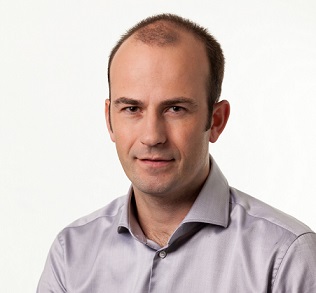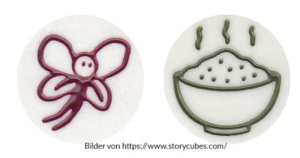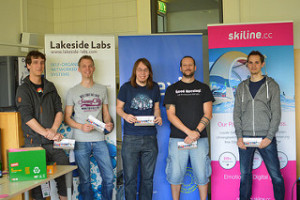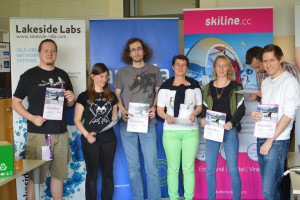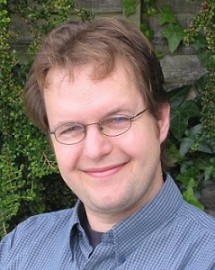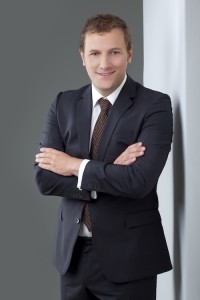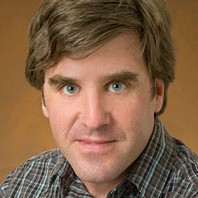Prof. Johannes Huber | 20.06.2016 | 17:00 Uhr | Lakeside B04, B4.1.114
Kurzfassung
Mit der Entwicklung der Informationstheorie gelang C. E. Shannon, dessen 100. Geburtstag heuer im Mai durch zahlreiche Feiern gedacht wurde, bereits im Jahre 1948 der Beweis, dass mittels Codierverfahren auch über gestörte Übertragungskanäle prinzipiell eine fehlerfreie digitale Übertragung möglich ist, solange nicht versucht wird, mehr Daten zu übertragen als die Kapazität des Kanals zulässt. Dieses Kanalcodierungstheorem leitete eine breite Forschungstätigkeit auf dem Gebiet der Kanalcodierung ein. Dennoch wurden über viele Jahre trotz des Einsatzes anspruchsvollster mathematischer Methoden nur eher bescheidene Fortschritte erreicht und das Ziel, die informationstheoretische Kapazität von Übertragungskanälen in der Praxis nutzbar zu machen, galt viele Jahre als grundsätzlich unerreichbar. Erst durch die Zufallserfindung der sog. „Turbo-Codes“ kam 1993 neue Bewegung in das Gebiet und dabei stellt es sich heraus, dass die Entwicklung durch das wenig geeignete Optimierungsziel „Maximierung der Minimaldistanz“, das aber niemals hinterfragt worden war, in eine ungünstige Richtung gelenkt worden war. Schließlich erkannte McKay 1996, dass die bereits 1963 von R. Gallager vorgeschlagenen „Low Density Parity Check Codes“ von allen bisher bekannt gewordenen Ansätzen wohl der direkteste Weg nahe an die Kanalkapazität gewesen wäre. So war das Problem eigentlich bereits 33 Jahre lang weitgehend gelöst, ohne dass dies bemerkt worden war. Im Jahr 2007 stellte schließlich Erdal Arikan mit der Erfindung der Polar Codes einfache Codier- und Decodierverfahren vor, durch die für eine nach unendlich strebende Codewortlänge die Kanalkapazität mathematisch beweisbar erreicht wird. Wieder zeigte sich, dass mit den nahe verwandten Reed-Muller Codes infolge des falschen Optimierungskriteriums bereits 53 Jahre zuvor das Ziel nur knapp verfehlt worden war.
Im Vortrag wird ausgehend von der Shannon´schen Informationstheorie der Begriff Kanalkapazität eingeführt. Die Wissenschaftsgeschichte wird anhand von verschiedenen Lösungsansätzen nachgezeichnet und es werden die Hemmnisse, die dabei zu Irr- und Umwegen geführt haben, identifiziert. Ein Ausblick auf die aktuelle Forschung und offene Fragen schließt den Vortrag ab.
Folien:
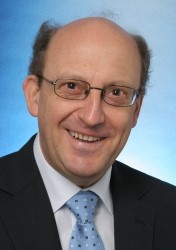
Johannes Huber studierte Elektrotechnik an der Technischen Universität München und erwarb 1977 das Diplom. Er wurde 1982 zur Dr.-Ing. promoviert und erhielt 1991 den Titel Dr.-Ing. habil. mit einer Monographie zur Trelliscodierung. Seit 1991 ist er Professor für Nachrichtentechnik und Leiter des Lehrstuhls für Informationsübertragung an der Friedrich-Alexander-Universität Erlangen-Nürnberg. Von 2007 bis 2009 war er Dekan der Technischen Fakultät.
In der Forschung ist Johannes Huber auf den Gebieten digitale Übertragung, Informations- und Codierungstheorie, codierte Modulation, Entzerrungs- und Detektionsverfahren, MIMO-Übertragungsverfahren, DSL etc. aktiv. Er hat zwei Monographien verfasst und ist Autor und Co-Autor von ca. 330 wissenschaftlichen Veröffentlichungen. In den Jahren 1988, 2000 und 2006 wurden Publikationen, die er verfasst bzw. mit verfasst hat, mit dem Preis der deutschen informationstechnischen Gesellschaft ausgezeichnet. 2004 erhielt er den Innovationspreis der Vodafone-Stiftung für Mobilfunk und in den Jahren 2003 und 2010 wurde ihm der EEEfCOM Innovationspreis verliehen.
Prof. Huber ist Fellow of the IEEE, Corresponding Fellow of the Royal Society of Edinburgh und ordentliches Mitglied der Bayerischen Akademie der Wissenschaften (BAdW). An der BAdW leitet er die Kommission „Forum Technologie“ und ist stellvertretender Sprecher der Sektion III: Naturwissenschaften, Mathematik, Technikwissenschaften.
Inzwischen sind 11 seiner ehemaligen Doktoranden selbst Professoren an namhaften Universitäten und Hochschulen.



